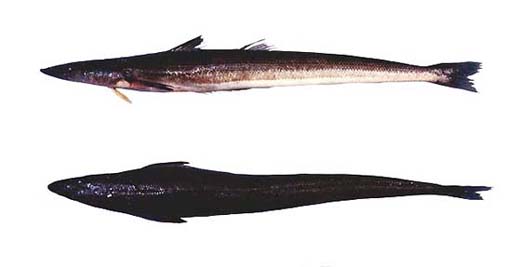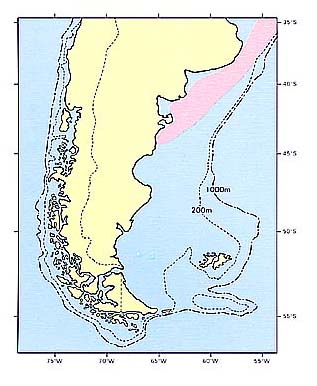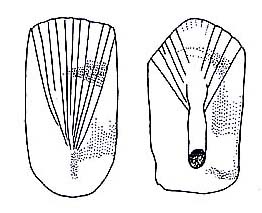ホカケトラギス科
- HOME
- デジタル図鑑
- パタゴニア海域の重要水族
- 硬骨魚綱 スズキ目
- ホカケトラギス科
ホカケトラギス科(Percophidae)

Dorsal view
104 ペスパロ(Pesuparo)
Percophis brasiliensis Quoy et Gaimard, 1824
Merluza real, Pez palo, Congrio real (Arg.); Congrio real (Urg.), Tira-vira (Br.)
特 徴:
第1背鰭8~10棘,第2背鰭30~33軟条,臀鰭40~41軟条,胸鰭17~18軟条,腹鰭1棘,5軟条,鰓耙数4~5+1+12~18=18~24。体長に対する頭長の割合は24.0~24.4%,眼径は2.0~2.5%,体高は8.7~10.5%,吻長は6.4~6.5%,両眼間隔は2.9~3.3%,上顎高は8.6~8.8%,尾柄高は3.9~4.4%,胸鰭長は12.3~13.3%,腹鰭長は8.3~9.2%,第1背鰭高は8.5~10.7%,第2背鰭高は7.3~8.4%,臀鰭高は4.4~5.4%。頭は小さく縦扁する。下顎は上顎より長く,前方に突出する。口は大きく,上顎後縁は眼の中央下に達する。両顎と口蓋骨に1列の鋭い歯があり,上顎前端には数本の大きな犬歯がある。鋤骨に絨毛状歯帯がある。小櫛鱗が体全体を被い,頭部と鰓蓋部も被鱗する。側線は鰓蓋上縁に発し,体側中央を直走し尾鰭基部に達する。第1背鰭基底は第2背鰭基底より短い。臀鰭は第1背鰭起部直下よりわずかに後方から始まり,その基底は第2背鰭基底より長い。胸鰭はやや下位で長く,先端は肛門に達する。胸鰭基底上方に大きな鱗性皮弁がある。腹鰭は喉位。尾鰭後縁は湾入し,上葉は下葉よりやや長い。体の背部と側部は褐色で,腹部は白い。体長は少くとも50cmに達する。肉質は白身で良好。
分 布:
ブラジル南部からアルゼンチン北・中部の陸棚上。
備 考:
Nelson(1976)は1属1種の本種をペスパロ亜科Percophidinaeに置き,他の2亜科(Bembropsinae, Hemerocoetinae)と区別した。1977年から1982年にかけてのアルゼンチンにおける本種の漁獲量は,4709t,4078t,2897t,2686t,2731t,3494tとなっている(FAO,1984)。
(中村 泉)
Material examined:
8 from Argentina (420.5-615.0 mm SL), FAKU 42772, 42807, 43004; AP 676-679, 691.
Description:
D Ⅷ-Ⅹ-30-33; A 40-41; P1 17-18; P2 Ⅰ, 5; GR 4-5+1+12-18=18-24. HL 24.0-24.4% of SL; ED 2.0-2.5; BD 8.7-10.5; SN 6.4-6.5; IO 2.9-3.3; UJ 8.6-8.8; CP 3.9-4.4; P1L 12.3-13.3; P2L 8.3-9.2; D1H 8.5-10.7; D2H 7.3-8.4; AH 4.4-5.4.
Body extermely elongate, depressed anteriorly, cylindrical posteriorly. Snout especially depressed, pointed, so head triangular in dorsal view. Mouth large, posterior margin of upper jaw extending slightly over center of eye, lower jaw apparently more produced forward than upper jaw. Anterior teeth on lower jaw visible even when mouth closed. About 6 fang-like teeth on each upper jaw, villiform inner teeth in band and about 25 sharp caniniform teeth uniserial on upper jaw and 10-12 sharp conical teeth uniserial on lower jaw, outer teeth on upper jaw smaller and arranged more closely than teeth on lower jaw. Numerous villiform teeth in band on vomer. Villiform inner teeth in band and sharp caniniform outer teeth on palatines. Nostrils situated closely and nearer to eye than tip of snout, anterior nostril circular with a tube around and posterior nostril crescent. Eye small, 9-11 times in head. Gill-rakers short and slender with inner serrations. Pseudobranchiae well developed. Pectoral fin moderate in size with a well developed scaled flap, its length slightly longer than half of head. Pelvic fin situated extremely anterior to pectoral fin origin, its length about one-third of head. First dorsal fin with short base. Anal fin bese longer than second dorsal fin bese. Caudal fin subtruncate. Head and body covered with small ctenoid scales. Lateral line fairly straight from about upper gill-opening insertion to caudal fin base. Pyloric caeca numerous, dendritic.
Distribution:
Off southern Brazil to central Argentina.
Remarks:
Attains large size, at least 50 cm SL. Percophidae is monotypic, and considered to be closely related to Parapercidae.
(Izumi NAKAMURA)

Distribution of Percophis brasiliensis in Patagonia.

Scale below mid lateral line (left) and lateral line scale (right).
- 1